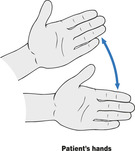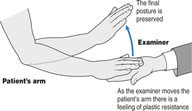DISORDERS OF APPEARANCE AND BEHAVIOUR
General appearance
Self-neglect
Evidence of self-neglect may include:
• A lack of cleanliness in self-care
• Unkempt hair
• Wearing clothes that have not been looked after.
Self-neglect may be consistent with the following psychiatric disorders:
• Dementia
• Psychoactive substance use disorder (of both alcohol and illicit drugs)
• Schizophrenia
• Mood disorder.
Recent weight loss
Evidence of recent weight loss may be provided by poorly fitting clothes that appear too loose. This may result from certain organic disorders, such as carcinoma, and in psychiatric disorders such as depression.
Flamboyant clothing
A patient may be dressed in a colourful, flamboyant way if under the influence of certain psychoactive substances or if suffering from mania.
Hypothyroidism
This is associated with the following signs, which may be evident from the general appearance (including from the hands on shaking hands with the patient):
• Dry, thin hair (often brittle and unmanageable)
• Facial changes – see below
• Dry skin
• Deafness
• Mild obesity
• Goitre
• Anaemia
• Cold hands.
Hyperthyroidism
This is associated with the following signs, which may be evident from the general appearance (including from the hands on shaking hands with the patient):
• Exophthalmus and other facial changes (see below)
• Goitre
• Tremor
• Weight loss
• Warm hands
• Palmar erythema.
Primary hypoadrenalism (Addison’s disease)
This may be associated with:
• Pigmentation of palmar creases and over joints of the hand
• Pigmentation of recent scars
• Dehydration
• Vitiligo
• General wasting
• Weight loss.
Facial appearance
Depression
Depressed patients often have:
• Downcast eyes
• A vertical furrow in the forehead
• Downturning of the corners of the mouth.
Mania
Manic patients may look euphoric and/or irritable.
Anxiety
Anxiety in general may be associated with:
• Raised eyebrows
• Widening of the palpebral fissures
• Mydriasis
• The presence of horizontal furrows in the forehead.
Parkinsonism
Relatively fixed unchanging facies may be caused by parkinsonism, which in turn may result from:
• Parkinsonian side effects of antidopaminergic antipsychotic treatment (used in the pharmacotherapy of schizophrenia and mania, for example)
• Parkinson’s disease.
Bulimia nervosa
In bulimia nervosa the face can have a chubby appearance owing to parotid gland enlargement; facial oedema may also occur as a result of purgative abuse. Both are rare.
Hirsutism
Hirsutism in female patients, particularly if accompanied by menstrual disturbances, may result from the following causes:
• Normal hair growth, e.g. in some Mediterranean and south Asian populations
• Polycystic ovary syndrome (the Stein–Leventhal syndrome is a severe form)
• Late-onset congenital adrenal hyperplasia
• Cushing’s syndrome
• Virilizing tumours of the ovaries or adrenal glands.
Hypothyroidism
This may be associated with the following signs, which may be evident from the facial (and neck) appearance:
• Dry thin hair (often brittle and unmanageable)
• Loss of eyebrows.
• Dry skin
• Goitre
• Large tongue
• Periorbital oedema
• Anaemia.
Hyperthyroidism
This may be associated with the following signs, which may be evident from the facial (and neck) appearance:
Primary hypoadrenalism (Addison’s disease)
This may be associated with:
• Buccal pigmentation
• Pigmentation of recent scars
• Dehydration
• Vitiligo.
Cushing’s syndrome
This may be associated with:
• Moon face
• Acne
• Frontal balding in females
• Hirsutism
• Thin skin
• Bruising.
Posture and movements
Schizophrenia
The following abnormal movements may occur particularly in schizophrenia and sometimes also in other disorders
• Ambitendency – the patient makes a series of tentative incomplete movements when expected to carry out a voluntary action (Fig. 2.1)
 |
| Figure 2.1 (With permission from Puri BK, Laking PJ, Treasaden IH 2002 Textbook of psychiatry. Churchill Livingstone, Edinburgh.) |
• Echopraxia – the automatic imitation by the patient of another person’s movements; it occurs even when the patient is asked not to do it
• Mannerisms – repeated involuntary movements that appear to be goal-directed
• Negativism – a motiveless resistance to commands and to attempts to be moved
• Posturing – the patient adopts an inappropriate or bizarre bodily posture continuously for a long time
• Stereotypies – repeated regular fixed patterns of movement (or speech) that are not goal-directed
• Waxy flexibility (also known as cerea flexibilitas) – as the examiner moves part of the patient’s body there is a feeling of plastic resistance (resembling the bending of a soft wax rod) and that part then remains ‘moulded’ by the examiner in the new position (Fig. 2.2).
 |
| Figure 2.2 (With permission from Puri BK, Laking PJ, Treasaden IH 2002 Textbook of psychiatry. Churchill Livingstone, Edinburgh.) |
Depression
Depressed mood may be associated with poor eye contact, the eyes often being downcast as mentioned above, and hunched shoulders.
Mania
Mania may be associated with increased movements and an inability to sit still. Note that restlessness is also a feature of anxiety and of certain organic disorders (e.g. hyperthyroidism).
Tics
These are repeated irregular movements involving a muscle group. They may be seen in a number of conditions, including Huntington’s disease, Gilles de la Tourette’s syndrome, and following encephalitis.
Parkinsonism
This is associated with a festinant gait.
Underactivity
Stupor
In psychiatry (as opposed to neurology) the term stupor is used to describe a patient who is mute and immobile (akinetic mutism) but fully conscious. (It is known that the patient is fully conscious because sometimes the eyes, which are often open, may follow objects. Moreover, following the episode of stupor the patient may be able to remember events that took place during it.) The condition is sometimes disturbed by periods of excitement and overactivity. Stupor is seen in the following conditions:
• Catatonic stupor
• Depressive stupor
• Manic stupor
• Epilepsy
• Hysteria.
Depressive retardation
Obsessional slowness
This refers to slowed movements that may be secondary to repeated doubts and compulsive rituals.
Overactivity
Psychomotor agitation
There is excess overactivity, which is usually unproductive, and restlessness.
Hyperkinesis
There is overactivity, distractibility, impulsivity and excitability. It is seen particularly in children and adolescents.
Somnambulism
In this condition (also known as sleep walking) a person who rises from sleep and is not fully aware of the surroundings carries out a complex sequence of behaviours.
Compulsion
This is a repetitive and stereotyped seemingly purposeful behaviour. It is also referred to as a compulsive ritual and is the motor component of an obsessional thought. Examples of compulsions include:
• Checking rituals, in which the patient may repeatedly check that the front door is closed or that electrical switches are in the ‘off’ position, for example
• Cleaning rituals, in which the patient may repeatedly wash his/her hands, sometimes even to the point that the skin is damaged
• Counting rituals
• Dressing rituals
• Dipsomania: a compulsion to drink alcohol
• Polydipsia: a compulsion to drink water
• Kleptomania: a compulsion to steal
• Trichotillomania : a compulsion to pull out one’s hair
• Nymphomania: a compulsive need in the female to engage in sexual intercourse.
Social behaviour
Dementia
The patient may not act according to accepted conventions, for example by ignoring the interviewer.
Schizophrenia
The patient may act in a bizarre, aggressive or suspicious manner.
Mania
The patient may flirt with the interviewer and be sexually or otherwise disinhibited.
DISORDERS OF SPEECH
Stay updated, free articles. Join our Telegram channel

Full access? Get Clinical Tree







